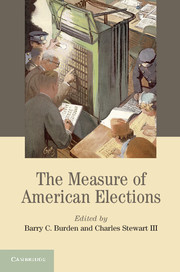Book contents
- Frontmatter
- Contents
- List of figures
- List of tables
- List of contributors
- Acknowledgments
- 1 Introduction to the Measure of American Elections
- 2 Registration and Voting: A View from the Top
- 3 Voter Registration: The Process and Quality of Lists
- 4 Provisional Ballots
- 5 Mail Ballots in the United States: Policy Choice and Administrative Challenges
- 6 Voting from Abroad: Evaluating UOCAVA Voting
- 7 Polling Place Practices and the Voting Experience
- 8 Disability and Election Policies and Practices
- 9 The Performance of Election Machines and the Decline of Residual Votes in the United States
- 10 Voter Confidence as a Metric of Election Performance
- 11 Election Data Transparency
- Appendix
- References
- Index
2 - Registration and Voting: A View from the Top
Published online by Cambridge University Press: 05 August 2014
- Frontmatter
- Contents
- List of figures
- List of tables
- List of contributors
- Acknowledgments
- 1 Introduction to the Measure of American Elections
- 2 Registration and Voting: A View from the Top
- 3 Voter Registration: The Process and Quality of Lists
- 4 Provisional Ballots
- 5 Mail Ballots in the United States: Policy Choice and Administrative Challenges
- 6 Voting from Abroad: Evaluating UOCAVA Voting
- 7 Polling Place Practices and the Voting Experience
- 8 Disability and Election Policies and Practices
- 9 The Performance of Election Machines and the Decline of Residual Votes in the United States
- 10 Voter Confidence as a Metric of Election Performance
- 11 Election Data Transparency
- Appendix
- References
- Index
Summary
Voter turnout may be the most widely hailed indicator of the robustness of a democracy. While it is true that lack of participation in a democratic system might sometimes indicate contentment, democratic reformers generally believe that more voter involvement is a good thing. Federal and state reforms have sought explicitly to increase registration and turnout rates. Initiatives such as the Voting Rights Act and provisions for overseas voters have been targeted at specific groups in society, while others, such as “motor voter” legislation and Election Day registration (EDR), have been aimed at the electorate as a whole. This chapter assesses levels of voter registration and turnout across the states, with a focus on the 2008 and 2010 elections, and how those rates are shaped by demographic, political, and policy factors at the state level.
This “view from the top” produces several conclusions. First, and perhaps surprisingly, a measure of registration based on the Current Population Survey (CPS) is often superior to one based on official state reports. Second, there is a great deal of inertia in turnout rates and especially registration rates, suggesting that state efforts to influence these rates have only limited effect in the short run. Third, there is substantial variation across states, more so than over time, indicating that state factors are quite important. Fourth, although registration and turnout rates are correlated, states vary significantly in the degree to which registrants actually vote. Fifth, turnout rates, and to a much lesser degree registration rates, are influenced by state election laws, suggesting they are appropriate indicators of election performance that can be influenced by state policy makers. Finally, there has been a convergence of states over time in terms of turnout that is likely the result of changes in demographics, campaigns, and election practices.
- Type
- Chapter
- Information
- The Measure of American Elections , pp. 40 - 60Publisher: Cambridge University PressPrint publication year: 2014
- 6
- Cited by

